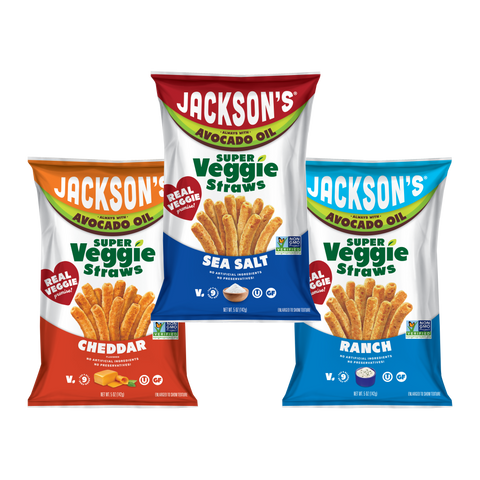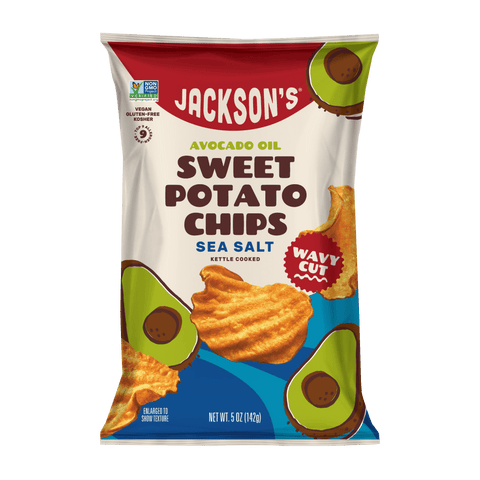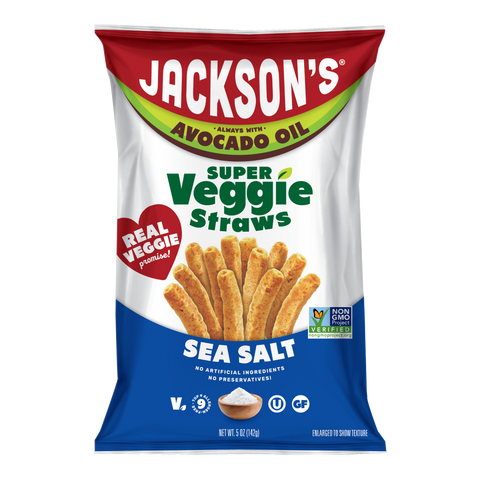Grapeseed Oil: What It Is, How It’s Made, and Why We Skip It

At Jackson’s, we’re all about wholesome, non-inflammatory ingredients that taste incredible and make you feel good. That’s why we cook with premium avocado oil and keep industrial seed oils off our ingredient list. Today, we’re digging into a popular kitchen staple and restaurant fryer favorite that often gets labeled as “clean” or “heart-healthy”: grapeseed oil.
You’ll find grapeseed oil in dressings, mayo, marinades, and tons of ultra-processed snacks. It’s praised for its neutral taste and high smoke point. But is it really the best choice for everyday cooking and snacking? Here’s what you should know.
What Is Grapeseed Oil?
Grapeseed oil is exactly what it sounds like: oil extracted from the seeds of grapes, most commonly as a byproduct of winemaking. Once grapes are pressed for juice or wine, the leftover seeds are dried and processed to extract oil.
Because grape seeds are tiny and naturally low in oil, getting that oil out is not simple or gentle. That brings us to the next point.
How Grapeseed Oil Is Made
While a small amount of cold-pressed grapeseed oil exists, the vast majority on store shelves is refined. Typical steps include:
-
High-heat drying and pressing: Seeds are heated and mechanically pressed to release oil.
-
Solvent extraction: Chemical solvents (often hexane) pull out additional oil to improve yield.
-
Refining: The crude oil is degummed, bleached, and deodorized to neutralize flavor, remove odors, and improve color. These steps involve additional heat and processing.
-
Standardization: Antioxidants may be added post-refining to slow rancidity.
Refining creates the neutral taste and pale color people expect from grapeseed oil, but it also strips away many natural compounds and exposes delicate fats to heat and air along the way.
Why Grapeseed Oil Became Popular
-
Neutral flavor: It doesn’t compete with other ingredients.
-
High smoke point on paper: Refined grapeseed oil is often listed around 420°F.
-
Marketing as a “light,” “clean,” or “heart-healthy” oil: Low in saturated fat, sometimes promoted for vitamin E.
Read: Grapeseed Oil vs Avocado Oil?

The Part You Don’t Always Hear
Highly polyunsaturated and fragile
-
Grapeseed oil is predominantly linoleic acid (omega-6 PUFA), often around 70% or more.
-
PUFAs are inherently less stable than monounsaturated or saturated fats when exposed to heat, light, and air.
-
Even with a high listed smoke point, a high-PUFA oil can oxidize and break down more readily during storage and cooking, forming off-flavors and reactive byproducts.
Read: Guide To Polyunsaturated Fats (PUFA)
Omega-6 overload without omega-3 balance
-
Grapeseed oil is extremely high in omega-6 and contains virtually no omega-3.
-
Many modern diets already skew heavily toward omega-6 fats. When omega-6 intake is high and omega-3 intake is low, it can tilt the body’s fatty acid balance in a direction that may promote pro-inflammatory pathways.
-
The issue isn’t that omega-6 is inherently “bad”—it’s that balance matters, and grapeseed oil does not help restore it leading to potential inflammation.
Oxidation and heat use
-
High-PUFA oils are more prone to oxidation during refining and cooking, especially at high heat.
-
Oxidation can generate compounds like aldehydes and other breakdown products you don’t want in your food.
-
Bottom line: smoke point is not the same as oxidative stability. An oil can have a high smoke point yet still be relatively unstable when heated.
Industrial processing, not minimal
-
Most grapeseed oil is solvent-extracted and heavily refined to make it palatable and shelf-stable.
-
While final products are tested for solvent residues, the overall process is a far cry from the simple pressing you get with many fruit oils.
Vitamin E claims, with a catch
-
You may see vitamin E listed as a perk of grapeseed oil. But refining reduces natural antioxidants, and high-PUFA oils may need added stabilizers to delay rancidity.
-
Also important: grapeseed extract (used as a supplement) is not the same as grapeseed oil. The extract can be rich in polyphenols; the refined cooking oil is not.
Is Grapeseed Oil “Heart-Healthy”?
It’s often marketed that way because it’s low in saturated fat. But health isn’t just about a single number; it’s about the whole picture:
-
Fatty acid balance: Grapeseed oil pushes omega-6 intake up without adding omega-3s which can lead to heart disease.
-
Stability: Highly unsaturated oils are more fragile and more likely to oxidize, especially under heat.
-
Processing: Heavily refined, solvent-extracted oils sit at odds with a whole-foods approach.
If you prioritize minimally processed fats with better oxidative stability and a more favorable fatty acid profile for cooking, grapeseed oil won’t top the list.
Read: Clean snacks with 3 or less ingredients
Cold-Pressed Grapeseed Oil: Any Better?
While rare and usually pricier, cold-pressed versions avoid solvents and can retain more of the oil’s native compounds. Two caveats:
-
It’s still very high in omega-6, so the balance issue remains.
-
It’s still fragile. Even without heavy refining, high-PUFA oils are not ideal workhorses for high-heat cooking and long shelf life.
Where You’ll Find Grapeseed Oil
You’ll find grapeseed oil in restaurant fryers and commercial kitchens, in bottled salad dressings and marinades, in mayonnaise and aioli, and throughout packaged snacks and crackers; it’s also a common choice in home kitchens for searing or “neutral” baking.
Why We Choose Avocado Oil Instead
At Jackson’s, we craft snacks you’ll feel great about eating. That’s why we never use industrial seed oils like grapeseed oil. We cook with avocado oil because it checks the boxes that matter to us and to you.
-
Minimally processed: High-quality avocado oil is typically expeller-pressed from the fruit’s pulp (not the seed), similar in spirit to olive oil.
-
Better stability for cooking: Avocado oil is rich in monounsaturated fat (oleic acid), which is more stable under heat than highly polyunsaturated oils.
-
Truly high-heat friendly: Refined, high-quality avocado oil has a high smoke point and better oxidative stability than high-PUFA oils.
-
Clean, neutral taste: It lets real ingredients shine.
-
Naturally nutrient-rich: Avocado oil retains beneficial compounds found in the fruit.
-
The best crunch in snacks!
Read: Avocado oil vs Olive oil
Smart Swaps: What To Use Instead of Grapeseed Oil
For everyday sautéing and roasting, choose avocado oil or extra-virgin olive oil—use extra-virgin olive oil for medium heat and high-quality refined avocado oil for higher heat; for high-heat frying, stick with refined avocado oil. For dressings and dips, reach for extra-virgin olive oil or a blend of extra-virgin olive oil and avocado oil, and for baking, use avocado oil, tallow or butter/ghee depending on the recipe.
Read: Tallow Snacks: Unlocking the Savory Goodness
How To Shop and Cook Smarter
-
Read labels: Grapeseed oil shows up in places you might not expect—dressings, mayo, sauces, crackers, and chips.
-
Store oils wisely: Keep oils away from heat and light, and use them within a reasonable time. If an oil smells paint-like, grassy-bitter, or just “off,” it’s likely oxidized.
-
Don’t equate smoke point with health: Consider the oil’s fatty acid profile and oxidation stability, not just the temperature at which it smokes.
Common Questions
Is grapeseed oil a seed oil?
Yes. Despite coming from a fruit, the oil is pressed from the grape’s seeds, so it’s classified as a seed oil.
Is grapeseed oil GMO?
Grapes used for grapeseed oil are generally not GMO. Our concerns focus more on the oil’s fatty acid profile, oxidative stability, and industrial processing.
Is grapeseed oil okay for skincare?
Many people like it for topical use because it’s light and absorbs quickly. Our perspective here is specifically about edible oils used for cooking and snacking.
Read: Non-GMO Snacks without any Seed Oil
The Jackson’s Bottom Line
We’re big believers in simple, high-quality fats that stand up to real-world cooking and taste amazing. Grapeseed oil’s ultra-high omega-6 content, industrial processing, and relative fragility under heat make it a no-go for our kitchen and our snacks. Avocado oil gives us the clean flavor, stability, and quality we insist on—without the compromises.
Empower Your Plate
-
Flip the bag, jar, or bottle and read the ingredients.
-
Choose stable, minimally processed oils for cooking.
-
Seek balance in your fats, not just a high smoke point.
When you reach for a bag of Jackson’s, you’re getting snacks cooked in premium avocado oil and crafted with care—no industrial seed oils, just bold flavor and better ingredients.
Read next: Exploring Examples of Non Seed Oils
No Seedy Oils Here
Avocado Oil Goodness Meets Irresistible Flavor - No Seed Oils Here!
-

 8 Pack New Arrival!Variety Pack Super Veggie Straws in Avocado Oil 5oz (Pack of 8)
8 Pack New Arrival!Variety Pack Super Veggie Straws in Avocado Oil 5oz (Pack of 8)Variety Pack
Super Veggie Straws in Avocado Oil
- Size
- 5oz bags
- Regular price
- $35.99
- Sale price
- $35.99
- Regular price
-
$35.99 (Liquid error (snippets/product-price line 131): divided by 0 per bag) - Unit price
- per
-

 8 Pack Best SellerSea Salt Sweet Potato Chips in Avocado Oil 5oz (Pack of 8)
8 Pack Best SellerSea Salt Sweet Potato Chips in Avocado Oil 5oz (Pack of 8)Sea Salt
Sweet Potato Chips in Avocado Oil
- Size
- 5oz bags
- Regular price
- $35.99
- Sale price
- $35.99
- Regular price
-
$35.99 (Liquid error (snippets/product-price line 131): divided by 0 per bag) - Unit price
- per
-

 8 PackWavy Sea Salt Sweet Potato Chips in Avocado Oil 5oz (Pack of 8)
8 PackWavy Sea Salt Sweet Potato Chips in Avocado Oil 5oz (Pack of 8)Wavy Sea Salt
Sweet Potato Chips in Avocado Oil
- Size
- 5oz bags
- Regular price
- $35.99
- Sale price
- $35.99
- Regular price
-
$35.99 (Liquid error (snippets/product-price line 131): divided by 0 per bag) - Unit price
- per
-

 8 PackVariety Pack Kettle Chips in Avocado Oil 5oz (Pack of 8)
8 PackVariety Pack Kettle Chips in Avocado Oil 5oz (Pack of 8)Variety Pack
Kettle Chips in Avocado Oil
- Size
- 5oz bags
- Regular price
- $35.99
- Sale price
- $35.99
- Regular price
-
$35.99 (Liquid error (snippets/product-price line 131): divided by 0 per bag) - Unit price
- per








